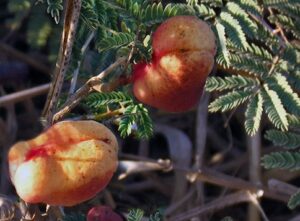Summary of Kalanit study tour to the Southern Coastal Plain and the Western Negev – February 7 & 8, 2018
Avi Shmida, the Department of Evolution and Econology, and the Center for the Study of Rationality at the Hebrew University in Jerusalem, Givat Ram, avi.shmida@gmail.com
Mimi Ron – Open Landscape Institute, and the Society for the Protection of Nature in Israel. mimiron47@gmail.com
Gadi Pollak – Kalanit editorial board. gadpollak@gmail.com
Keywords: Allysum, Paronychia argentea, Paronychia arabica, batha, Ophrys "Be'eri", Gagea fibrosa, Gagea circumplexa, red loam, limestone, loess in the Western Negev, Coastal Plain, Lobularia, Fibonacci number, Sencio, Orchis collina, sand plants, endemic plants, calciphobic plants, calciphyllic plants, Retama raetam, Helianthemum stipulatum
In this study tour the habitats of the Southern Coastal Plain and the Western Negev were studied, with emphasis on the climatic, geomorphological, and edaphic (soil and geology) uniqueness of the Coastal Plain. The make-up of the vegetation in the stations of the study tour, presented a unique combination of Mediterranean elements, whose source is in the scrub and batha, that grow on a calcareous subsoil, together with Saharo-Arabian elements originating in the sand deserts. The Southern Coastal Plain and the Western Negev have enjoyed in recent years – this year included – quantities of rain above the perennial average. Despite the delay in the first periods of rain at the beginning of the winter, during the study tour the whole area was already green, the wave of flowering had begun, and was expected to intensify towards the end of February.
Summary of Kalanit study tour to the Tel Gador Nature Reserve, the Amir Ridge, the Iron Forest and the Valley of Peace near Yokne'am – February 22, 2018
Avi Shmida, the Department of Evolution and Econology, and the Center for the Study of Rationality at the Hebrew University in Jerusalem, Givat Ram, avi.shmida@gmail.com
Mimi Ron – Open Landscape Institute, and the Society for the Protection of Nature in Israel. mimiron47@gmail.com
Gadi Pollak – Kalanit editorial board. gadpollak@gmail.com
Keywords: Ulmus canescens, Iris atropurpurea, Iris grant-duffi, foothills, Hyoseris scabra, the Alon Tabor Park Forest, Anemone coronaria, Michauxia campanuloides, the Coastal Plain, Laurus nobilis, phenology, efflorescence, Ramat Menashe
The early spring flowering has already begun in the Coastal Plain regions , and the lower altitude regions of the foothills. The mild winter enables relatively fast vegetative growth following the first winter rains, and a quick passage to התמיינות for flowering. The Crown Anemone (Anemone coronaria), in all its shades, is already at the end of its flowering, and is accompanied by the early spring bloomers of the Cruciferae, Asteraceae and Umbelliferae families. The Coastal Iris (Iris grant-duffi) in the Tel Gador Nature Reserve was at the peak of its flowering. It too is accompanied by the abundant flowering of the herbaceous plants that are typical of sand dunes. The main findings of the study tour were the Rugged Hyoseris (Hyoseris scabra) and the Rough-leaved Michauxia (Michauxia campanuloides) on the "Canyon of the Tigers" Path.











